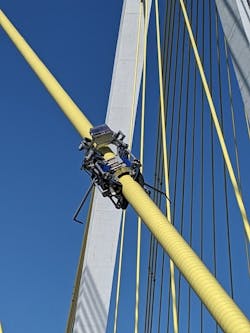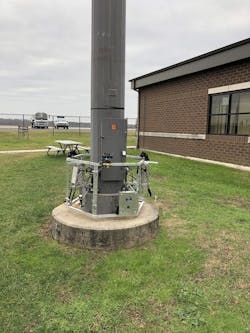The dawn of robotic inspection services for infrastructure safety
Routine, in-depth inspections of bridges and infrastructure are pertinent to assessing the life span of an asset and maintaining public safety for those who use them every day.
According to the American Society of Civil Engineers, there are over 617,000 bridges across the country, 42% of which are 50 years old or more. Not only are they aging, but 7.5% of all the nation’s bridges are considered structurally deficient. Given the number of vehicles on the roads each day, inspection of America’s infrastructure is top of mind.
Traditionally this process involves costly inspections, potential damage to the asset, and disruption to the flow of traffic. Today, new robotic technology makes inspections more efficient, more accurate, and safer for inspectors and the motoring public.
Two rapidly growing areas of adoption for robotics include the inspection of bridge stay cables and high mast light poles (HMLP).
Traditionally, the exterior of bridge stay cables are visually inspected by rope-access climbers (inspectors) who harness themselves to the bridge stay cable. In randomly selected locations, cable wedging is performed to inspect the interior of the sheathing for possible deterioration or corrosion of the stay cable. Ironically, cable wedging allows for additional moisture to penetrate the sheathing, causing further corrosion and/or deterioration of what inspectors are trying to properly maintain.
Today, industry-leading wireless robotic nondestructive testing (NDT) equipment offers the capability of performing real-time evaluations of a bridge’s stay cables. This robotic equipment wirelessly attaches to the exterior of the sheathing and “peers through” the sheathing to detect and quantify loss of metallic area (LMA) and individual broken wires within stay cables. This equipment can inspect 100% of the stay cables and provides quantitative data, rather than performing a select few subjective visual inspections.
Another benefit of this technology is a real-time evaluation with a permanent record of findings to help document any concerns and keep an ongoing record during subsequent inspections to track the progression of any anomalies detected.
In addition to performing NDT, leading solutions also have the ability to perform 360° close visual inspection (CVI) of the exterior of the sheathing, exceeding the close-visual requirements of National Bridge Inventory (NBI), American Association of State Highway and Transportation Officials (AASHTO), and Federal Highway Administration (FHWA) biannual inspections. Furthermore, full-length video and still photographs of the entire inspection process are provided for permanent inspection records.
Most importantly, robotics can make bridge stay cable inspections safer for inspectors and the traveling public, as such undertakings no longer require lane closures or the use of bucket trucks.
This NDT method can also extend the service life of critical infrastructure and help time repairs and maintenance to avoid untimely replacements.
Standing at 50 ft or taller, it is easy to see how a structurally deficient HMLP poses significant safety risks, as they are typically situated near highways and other high-traffic areas. Regular inspections of a HMLP are vital to maintaining public safety.
These industry-leading robotic devices can also be used to perform a real-time, 360° CVI of the entire HMLP. The CVI exceeds FHWA and AASHTO guidelines and replaces unreliable manual methods with permanent inspection video records, providing owners consistent and repeatable results over successive inspections.
These wireless robotic equipment options provide HD video and photographs to track corrosion deterioration progression over time. Robotics can offer a complete assessment of pole sleeves, seams, mast arms, and luminaries. In addition to inspecting HMLPs, robotic technology is also a viable application for several ancillary structures, including but not limited to overhead sign structures and other light structures.
Similar to bridge stay cable inspections, robotics eliminate the need for lane closures, bucket trucks, and climbers, and improve overall safety for the inspector and the motoring public.
According to the FHWA, there were 842 work zone fatalities in 2019 alone—a saddening statistic that the advent of this technology hopes to reduce. Furthermore, by limiting lane closures and traffic disruptions, robotic NDT technology makes the roads and bridges we all drive on safer and less expensive to maintain for everyone.
With safety at its core, robotic technology aims to positively evolve the industry and make life safer for every single one of us.


